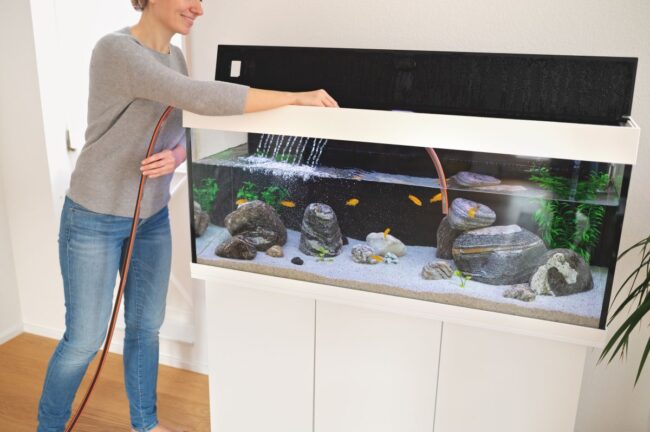Cloudy water in aquariums is not only unpleasant to look at, but usually suggests that there are some problems with your setup and could even put your fish in danger.
To restore a healthy environment, cleaning the murky water is crucial. Regular maintenance can prevent this. For example, do 25% weekly water changes and remove debris for 2-3 weeks in a row in order to properly clean the water.
You do have to find the cause of the problem, though. Usually, it’s an excess of nutrients that is causing it (aka feeding your fish too much).
This leads to uneaten food sinking to the bottom. High levels of nitrogenous waste also increase organic matter. This promotes bacterial growth, causing murky water.
Therefore, you should make sure that you should feed your fish no more than what they can consume in a few minutes.
Adequate filtration is also critical for maintaining clear water. Replace or clean filter media to improve clarity. You can read how to set up your aquarium filter here and also read if it should be under water or not.
Pro Tip: Avoid overstocking with fish or snails and such. Too much biomass can trigger an algae bloom, leading to cloudy water. Your fish may think it’s a mud bath, but it’s not doing them any favors.
Causes of Cloudy Water in Freshwater Aquariums
Cloudy water in freshwater aquariums is a common problem for aquarists. This can be caused by many things, such as overfeeding, poor filtration, and waste build-up.
This leads to bacteria, microorganisms, and organic matter in the tank, as well as a potential algae bloom.
Keeping the water clear is essential for aquatic life, so it’s important to figure out the cause and take action. Cleaning the tank regularly, taking out debris, changing water, using high-quality filters, and not overfeeding can help.
If you have more fish than you should (most recommend 1-inch of fish size per gallon of water, so most aquariums are overpopulated), you will need to clean more often.
Fish create organic waste and too many could result in a faulty water that becomes cloudy. You can help here, apart from regular water changes, by adding more plants and a better filter for your aquarium.
But too many fish are just too many in most cases – so if overpopulation is getting out of control, you have to figure a way to solve that problem (donate the extra fish or start a new aquarium).
Also, make sure that it is indeed your water that is cloudy and not the glass of your aquarium. I have an article on how to clean a cloudy aquarium glass too, in case you need that.
How to Clean Cloudy Water in Your Aquarium

Let’s get a bit more in depth with the actual things one should do if cloudy water becomes a problem.
- Change Water Regularly: The most fundamental solution to tackle cloudy water is to keep your aquarium water clean. Change around 25% of the water every 2 weeks to keep it fresh enough, but also not to destroy the balance created in the aquarium.
- Maintain Proper Filtration: To ensure effective filtration, use high-quality filters that are suitable for the size of your aquarium. Clean the filter regularly and replace it every few years (or more often if needed).
- Algae Control: Overgrowth of algae may lead to cloudy water. Therefore, it is essential to prevent excessive algae by using an adequate lighting, and avoiding direct sunlight or overfeeding. Having algae eating fish also helps.
- Maintain Proper Water Chemistry: Improper pH balance, hard water, and inadequate mineral balance may also cause cloudy water. Test and maintain ideal water parameters that are suitable for your fish species.
- Use Clarifiers: Water clarifiers help in coagulating small particles, making it easier for the filter to remove them. Only use clarifiers as suggested by the manufacturer, and avoid unnecessary overdosing. I also recommend doing this as a last resort measure because it can be done without the use of extra chemicals.
Additionally, remember to avoid overcrowding and use high-quality food. A balanced ecosystem is the key to a healthy aquarium.
Use Aquarium Plants to Clean Water
Aquarium plants can make your freshwater tank clean and healthy for your aquatic pets. Here’s how:
- They absorb excess nutrients like nitrates and phosphates that cause algae growth.
- Plants release oxygen into the water during photosynthesis, improving its quality.
- The roots of plants contain beneficial bacteria that breakdown waste products.
Plus, they come in many varieties and add beauty to your tank. Choose the right plant species based on lighting, substrate type, and compatibility with other fish.
If you need help, you can check out my previous article sharing the best low-light plants for aquarium as well as the best plants for cold water aquariums if you have such a tank.
Conclusion
Keeping freshwater aquarium water clear is difficult, especially if you’re just starting with this amazing hobby. But trust me when I say it – it gets easier as your fish tank becomes more established and as you get more experience.
But when cloudy water appears, determine the root of the cloudy water by inspecting the filter, feeding, and other factors. Then, get the right solution: water changes, chemical treatments, reducing the fish population or better filtration.
Remember that dirty aquarium water can cause diseases and unsuitable living conditions for our pet fish. To protect them, we must stay devoted to cleanliness and good practices.
Frequently Asked Questions
Q: Why is my aquarium water cloudy?
A: Cloudy water in your aquarium can be caused by a number of factors, including overfeeding, overstocking, inadequate filtration, or a buildup of debris and waste.
Q: Can cloudy water harm my fish?
A: Yes, cloudy water can be harmful to fish as it can contain high levels of toxins and bacteria that can compromise their health and well-being.
Q: How can I clean cloudy water in my aquarium?
A: Cloudy water can be cleaned by performing a partial water change, increasing the frequency of your water changes, cleaning or replacing the filter media, and removing any debris or waste from the tank.
Q: How often should I clean my aquarium?
A: It is recommended to perform regular partial water changes and clean your filter media at least once a month to maintain a healthy and clean aquarium environment.
Q: What types of filtration are best for clearing up cloudy water?
A: Mechanical and biological filtration are the best types of filtration for clearing up cloudy water in your aquarium.
Mechanical filters can remove debris and waste particles, while biological filters can break down harmful toxins and bacteria.
Q: Can I use chemicals to clear up cloudy water?
A: While chemicals like water clarifiers can help clear up cloudy water, it is not recommended as they can harm beneficial bacteria and disrupt the natural balance of your aquarium.

